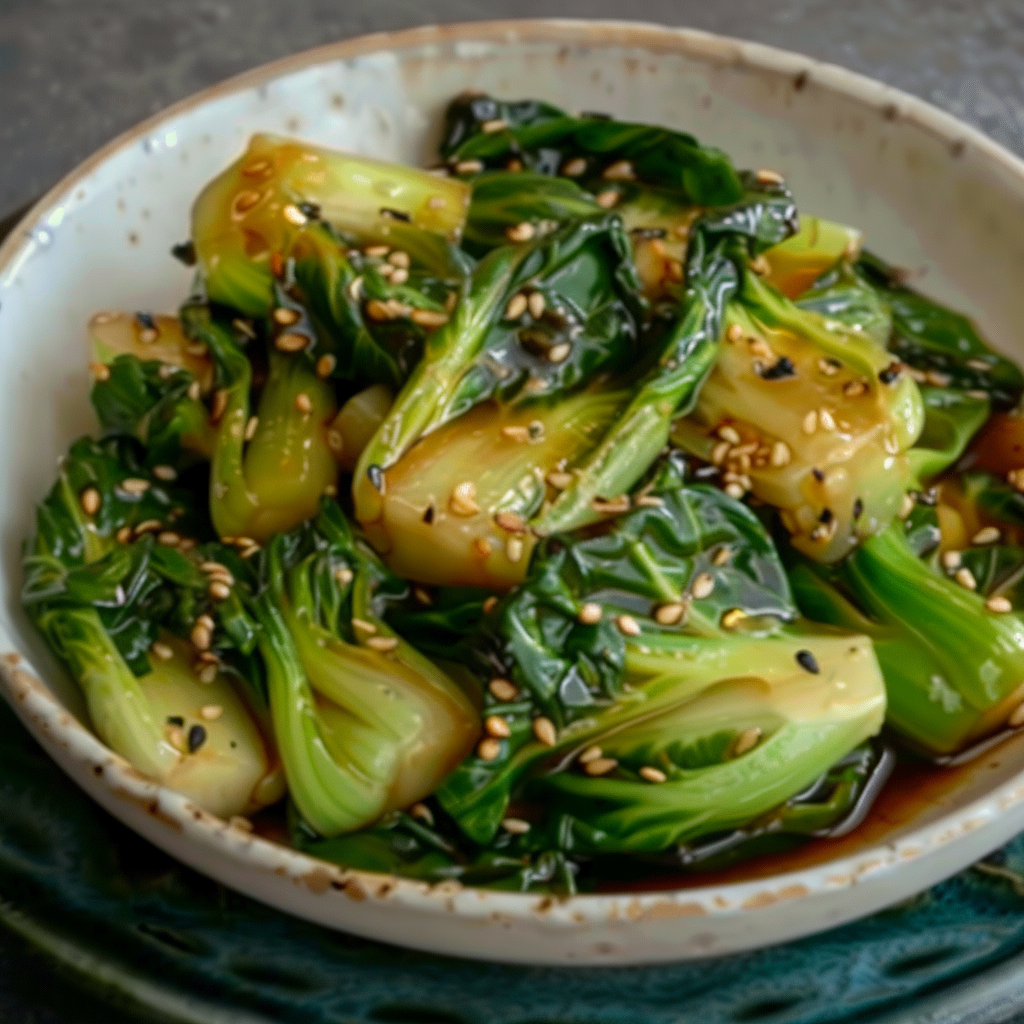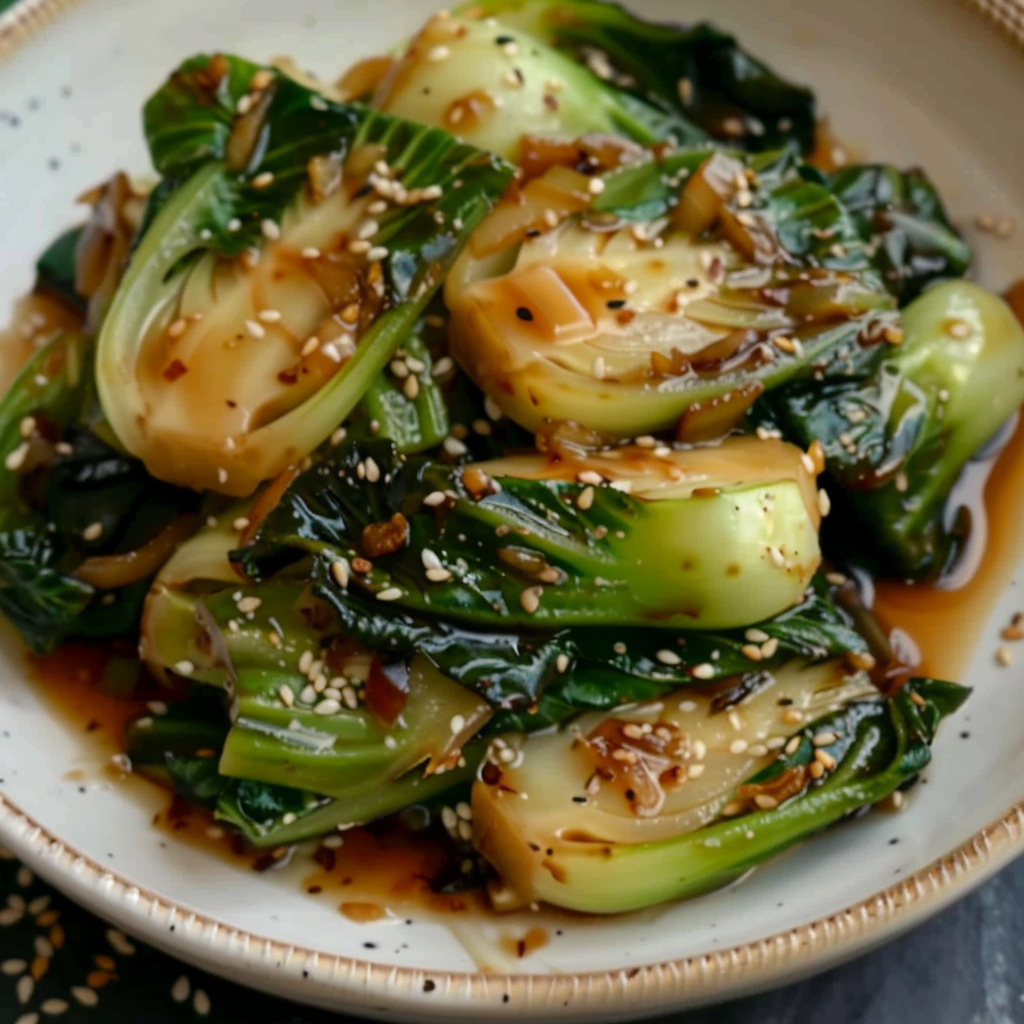Ginger Garlic Bok Choy Stir Fry
When it comes to quick, flavorful, and healthy side dishes, ginger garlic bok choy stir fry stands out as a consistent favorite in Asian cuisine. The combination of aromatic garlic and zesty ginger with tender yet crisp bok choy creates a dish that’s both simple to prepare and layered in taste. Whether you’re serving it alongside steamed rice, noodles, or a protein main, this dish is a versatile addition to any meal plan.
Bok choy, also known as Chinese cabbage, is especially popular in stir-fried dishes for its balance of texture — tender green tops and crunchy white stalks. What makes this recipe unique is its ability to preserve the natural color and crunch of the vegetable while infusing it with deep umami flavors from soy sauce, sesame oil, and optional additions like oyster sauce and honey. The technique of stir-frying at high heat ensures every bite is perfectly seared and well-seasoned without being soggy.
The ingredients are straightforward and likely already in your pantry. Garlic and ginger are more than just flavor boosters; they bring numerous health benefits and are commonly used in Asian cooking for their immune-supporting properties. Garlic and ginger, both featured prominently in this dish, are also known for their anti-inflammatory and digestive benefits.
For those seeking a deeper dive into the cooking process, exploring the stir frying technique can offer tips on achieving the perfect texture and heat control. If you’re building a meal around this dish, Pinterest is a great resource for finding healthy Asian sides and quick vegetable stir fry ideas that complement this recipe beautifully.
This crispy tender bok choy stir fry is more than a side — it’s a vibrant, nutritious plate of color and bold flavor, anchored by two powerhouse aromatics: ginger and garlic. Whether you’re new to cooking Asian dishes or looking for something healthy and fast, this one ticks every box.

What Is Bok Choy?
Bok choy is a leafy green vegetable from the Brassica family, closely related to cabbage and kale. Its mild flavor and tender texture make it one of the most beloved ingredients in Asian vegetable dishes. Often called Chinese cabbage, bok choy has been cultivated for centuries and is featured in soups, stews, and especially stir fry recipes for its ability to absorb flavors beautifully while maintaining a satisfying crunch.
There are two main varieties of bok choy: the larger, mature type and the smaller, more delicate baby bok choy. The latter is most often used in dishes like ginger garlic bok choy stir fry because it cooks evenly and has a slightly sweeter taste. The white stalks turn tender and juicy when cooked, while the green leaves wilt just enough to become silky and flavorful.
According to Wikipedia’s page on bok choy, this vegetable is not only prized for its taste but also for its impressive nutritional profile. It’s rich in vitamins A, C, and K, and it’s an excellent source of calcium and antioxidants. These nutrients help support bone strength, immune health, and overall vitality. For those interested in how this fits into a balanced diet, you can check out more Asian vegetable recipes on Pinterest that feature bok choy and similar greens.
Because bok choy cooks quickly, it’s a great option for those who prefer light meals that don’t sacrifice flavor. It pairs well with garlic, soy sauce, sesame oil, and ginger—a flavor combination that perfectly captures the heart of traditional Chinese home cooking. When stir-fried correctly using high heat (a method explored on stir frying technique), the result is a dish that’s tender in the greens and crisp in the stalks, embodying the perfect contrast in every bite.
Health Benefits of Bok Choy and Key Ingredients
Incorporating bok choy into your meals isn’t just a delicious choice—it’s a smart nutritional decision. This humble leafy green is a powerhouse of vitamins and minerals that support overall health. Rich in vitamin C, vitamin A, and vitamin K, bok choy helps boost immunity, improve vision, and strengthen bones. According to Wikipedia’s bok choy entry, it also contains folate, potassium, and calcium, making it ideal for heart health and muscle function.
One of the standout features of bok choy is its low-calorie, high-fiber profile. This combination promotes digestive health and aids in weight management. Its water content helps you feel full, making it a go-to for those following light or low-calorie Asian side dish recipes. You’ll also find bok choy used frequently in vegan Asian recipes that focus on whole foods and clean eating.
The benefits don’t stop with bok choy. This recipe also includes garlic and ginger, two ingredients known for their therapeutic properties. Garlic is loaded with compounds like allicin, which may reduce blood pressure and cholesterol. You can read more about its health value on Wikipedia’s garlic page. Ginger, another nutritional standout, is widely recognized for aiding digestion, reducing nausea, and providing anti-inflammatory effects. Visit Wikipedia’s article on ginger to learn how it’s been used in culinary and medicinal contexts across cultures.
Additionally, sesame oil and soy sauce bring more than just flavor. Sesame oil is rich in antioxidants and healthy fats, while soy sauce adds depth through natural fermentation, offering trace minerals and a complex umami profile.
Combining these ingredients in a quick stir-fry locks in both nutrition and flavor. It’s a smart way to eat well without spending hours in the kitchen. This makes ginger garlic bok choy stir fry an excellent addition to any health-conscious meal plan.
Key Ingredients Breakdown
Crafting a flavorful ginger garlic bok choy stir fry begins with understanding the role each ingredient plays. This dish is built around simple pantry staples that, when combined, create layers of flavor and texture. Here’s a detailed look at the key components:
-
Baby Bok Choy: The star of the dish, baby bok choy offers a perfect balance between tender greens and crunchy stalks. Choose heads that are bright green with crisp white stems, free from yellowing or wilt. This variety cooks quickly and absorbs sauces beautifully, making it ideal for stir fry.
-
Garlic: Used generously in this recipe, garlic adds a deep, savory note that complements the freshness of the bok choy. Fresh minced garlic releases more oils and flavor than pre-minced varieties. Garlic also provides notable health benefits, including immune system support. Learn more about its properties on Wikipedia’s garlic page.
-
Fresh Ginger: With its spicy, aromatic heat, ginger balances the pungency of garlic. It’s essential in many Asian recipes and brings both depth and brightness to the dish. Ginger also supports digestion and reduces inflammation. Explore its culinary and medicinal uses here.
-
Soy Sauce: This fermented seasoning is rich in umami and saltiness. A small amount goes a long way in bringing all the flavors together. You can dive into the traditional process and variations of soy sauce on Wikipedia’s soy sauce page.
-
Oyster Sauce (optional): If used, this adds a sweet-savory complexity and a glossy finish. For a vegan version, skip it or use mushroom-based alternatives.
-
Rice Vinegar: This light, slightly acidic ingredient lifts the flavor of the dish and balances the richness of soy and sesame oil.
-
Honey or Sugar (optional): A touch of sweetness can enhance the depth of flavor, especially when using oyster sauce. Adjust based on taste preference.
-
Sesame Oil: Used both for cooking and finishing, sesame oil contributes a nutty aroma that’s signature to many stir-fried dishes. A little goes a long way.
-
Sesame Seeds (optional garnish): While not essential, toasted sesame seeds add texture and a final burst of nuttiness.
For those looking to build a meal around this dish, consider checking out quick vegetable stir fry ideas for complementary options, or explore more Asian vegetable recipes for inspiration. These ingredients not only deliver flavor but also pack a nutritional punch, turning a simple side into a standout component of any healthy meal.
Equipment Needed for Stir Frying
To prepare a crispy and flavorful bok choy stir fry, using the right equipment is just as important as the ingredients. Stir frying is all about quick cooking over high heat, so the tools you use will determine your success in achieving that signature tender-crisp texture.
-
Wok or Large Skillet: A traditional carbon steel wok is ideal for even heat distribution and fast cooking. Its sloped sides allow for tossing ingredients easily, preventing overcrowding and ensuring every piece of bok choy sears properly. If you don’t have a wok, a wide nonstick or stainless steel skillet can work well—just make sure it’s large enough to avoid steaming the vegetables.
-
Spatula or Wok Turner: A long-handled spatula or wok chuan helps you stir and flip ingredients quickly without losing heat or control.
-
Lid for Steaming: A tight-fitting lid is essential for steaming the bok choy briefly in the sauce, softening the stalks while keeping the greens vibrant and intact.
-
Prep Bowls: Having all your mise en place—ingredients measured and prepped—in bowls helps keep the cooking process efficient. Stir frying moves fast, so there’s no time to measure mid-cook.
-
Tongs or Chopsticks: These can be useful for placing the bok choy cut-side down to sear properly and for gently turning without breaking the stalks.
Mastering stir fry technique involves understanding your tools and how they interact with heat. For those new to this cooking style, the Wikipedia page on stir frying offers excellent background on how this method developed and why it’s still a staple in Asian kitchens today. Once you’re familiar with your tools, every stir fry becomes easier, faster, and more flavorful.
How to Prep Bok Choy Properly
Proper preparation is essential for achieving the best flavor and texture when cooking bok choy. Because it grows close to the ground, bok choy often harbors dirt and sand between its stalks. Skipping this step can ruin the dish with unexpected grit, so attention to cleaning and cutting is key.
-
Rinse Thoroughly: Submerge the bok choy in a bowl of cold water and swish it around to release dirt from between the leaves and stalks. Repeat with fresh water if necessary.
-
Trim the Base: Cut off the tough root end, especially if using mature bok choy. For baby bok choy, simply slice the head in half lengthwise to expose more surface area for searing.
-
Dry Completely: After washing, pat the bok choy dry with a clean towel or use a salad spinner. Any excess water can cause oil to splatter and may lead to steaming rather than stir frying.
-
Optional Cutting: If you prefer smaller pieces, you can slice the halves into quarters. However, halved bok choy presents better visually and gives a satisfying bite when stir fried.
Prepping bok choy the right way ensures a crisp-tender result and allows the flavors of garlic, ginger, and sauce to coat the vegetable evenly. For more inspiration on preparing other vegetables for stir fry, explore quick vegetable stir fry recipes that highlight cleaning and prep techniques.

Stir Fry Technique for Bok Choy
The secret to an exceptional ginger garlic bok choy stir fry lies in mastering the cooking technique. Stir frying is all about speed, heat, and timing. When done correctly, it locks in flavor while preserving the fresh crunch and vibrant color of the vegetables.
-
Heat the Pan: Place your wok or skillet over medium-high to high heat. Wait until it’s hot enough that a droplet of water sizzles on contact.
-
Add Oils: Pour in the vegetable oil and sesame oil, letting them heat up briefly to coat the pan and release their aroma.
-
Aromatics First: Add minced garlic and fresh ginger. Stir continuously for about 30 seconds, just until fragrant. Be careful not to let them brown or burn.
-
Sear the Bok Choy: Place the halved bok choy cut-side down in the pan. Let it sear undisturbed for 1 to 2 minutes. This creates a golden-brown crust and intensifies flavor.
-
Flip and Add Sauce: Turn the bok choy over and add your soy sauce, optional oyster sauce, rice vinegar, honey or sugar (if using), and a splash of water.
-
Steam Briefly: Cover the pan with a lid and let it steam for 2 to 3 minutes. This step softens the stalks without overcooking the greens.
-
Uncover and Reduce Sauce: Remove the lid and cook for another minute. The sauce should reduce slightly and cling to the bok choy without becoming soupy.
-
Serve and Garnish: Transfer to a serving plate and sprinkle with toasted sesame seeds if desired. Serve immediately.
To explore how this stir fry method works across different vegetables, browse Asian vegetable recipes for additional inspiration. This process balances flavor and texture to create a satisfying and healthy side dish every time.
Serving Suggestions
This ginger garlic bok choy stir fry is a versatile side that complements a wide variety of main dishes. Its rich umami flavor and light texture make it an ideal pairing for both plant-based and protein-rich meals.
-
With Rice: Serve alongside jasmine or brown rice to create a simple, balanced meal. The sauce from the bok choy pairs perfectly with the grains.
-
With Noodles: Toss with soba, udon, or rice noodles for a quick vegetarian bowl. Add a drizzle of soy sauce and chili oil for an extra punch.
-
As a Side Dish: Pair with grilled tofu, teriyaki chicken, or steamed fish to round out a healthy dinner.
-
As a Light Main: For a low-calorie lunch, enjoy a generous serving on its own or with a poached egg on top for added protein.
You can find more serving ideas through curated healthy Asian sides that make use of similar ingredients and techniques. This dish can stand alone or play a supporting role in more elaborate spreads—either way, it never disappoints.
Recipe Variations and Customization Tips
One of the best features of this stir fry is its flexibility. Whether you follow a plant-based diet, prefer more heat, or want to turn this side into a main, there are endless ways to adapt it.
-
Make it Spicy: Add red pepper flakes, sliced fresh chili, or a squirt of Sriracha to the pan with the garlic and ginger.
-
Vegan-Friendly: Omit the oyster sauce and use additional soy sauce or a vegan substitute like mushroom sauce. Pair with tofu or tempeh for protein.
-
Protein Add-Ins: Stir fry with shrimp, thinly sliced beef, or diced chicken breast. Add after the garlic and ginger, cooking through before adding bok choy.
-
Swap the Greens: Substitute with choy sum, napa cabbage, or baby spinach if bok choy isn’t available.
-
Gluten-Free Option: Replace soy sauce with tamari to keep the dish gluten-free without compromising flavor.
Explore vegan Asian recipes to find more adaptable versions of this dish using clean, plant-based ingredients. These tweaks allow you to enjoy the essence of the recipe while tailoring it to your taste or dietary needs.
Storage and Reheating Tips
Leftover bok choy stir fry can be stored and enjoyed later, though it’s best served fresh to maintain texture. If storing, follow these steps:
-
Refrigeration: Place in an airtight container and refrigerate for up to 3 days.
-
Reheating: Warm gently in a skillet over medium heat or in the microwave. Add a splash of water or soy sauce if it looks dry.
-
Avoid Freezing: Bok choy’s water content makes it unsuitable for freezing—it tends to become mushy and lose its vibrant texture.
These tips ensure that your stir fry remains flavorful and enjoyable, even as a leftover lunch or side the next day.
Common Mistakes to Avoid
Even simple dishes like this one can go wrong if certain details are overlooked. Avoid these common pitfalls to get perfect results every time:
-
Overcrowding the Pan: Too many bok choy halves will steam instead of sear. Cook in batches if necessary.
-
Not Drying Bok Choy: Water causes oil to splatter and can dilute the sauce. Dry thoroughly before cooking.
-
Burning the Garlic: Add garlic to hot oil but stir constantly and keep it moving to prevent bitterness.
-
Overcooking: Bok choy should be crisp-tender, not limp. Stick to the timing and avoid over-steaming.
By understanding these common errors, your stir fry will be more consistent and flavorful with every attempt.

FAQs
Q1: Is bok choy better steamed or stir fried?
Stir frying is ideal if you want to preserve bok choy’s crisp texture and develop flavor through browning. Steaming softens it more but doesn’t create the same savory depth.
Q2: Do you eat the white or green part of bok choy?
Both! The white stalks are crunchy and juicy, while the green leaves are tender and flavorful. Stir frying cooks both evenly when cut properly.
Q3: Can I use regular bok choy instead of baby bok choy?
Yes, but slice it into smaller pieces for even cooking. Baby bok choy is sweeter and more tender, making it a preferred choice for stir fries.
Q4: What does bok choy taste like?
Bok choy has a mild, slightly peppery flavor similar to cabbage but less bitter. Its stalks are crisp and juicy, while the greens are soft and earthy.
Q5: How do I make stir fry bok choy not soggy?
Use high heat, dry the bok choy thoroughly, and avoid overcrowding the pan. Searing cut-side down also helps lock in moisture.
Q6: Can I prep bok choy ahead of time?
Yes. You can wash, cut, and dry bok choy a few hours in advance. Store it in a sealed container lined with a paper towel in the fridge.
Q7: Is bok choy good for weight loss?
Absolutely. Bok choy is low in calories, high in fiber, and packed with vitamins, making it a smart addition to weight-loss-focused diets.

Ginger Garlic Bok Choy Stir Fry
- Author: Naomi
Description
This ginger garlic bok choy stir fry is a quick and vibrant side dish featuring crisp baby bok choy seared in sesame oil, infused with the deep flavors of fresh garlic and ginger. A splash of soy sauce and vinegar creates a savory glaze, making it the perfect complement to rice, noodles, or your favorite protein. Ready in under 15 minutes, this dish is healthy, simple, and full of bold Asian flavors.
Ingredients
- 1 lb baby bok choy, halved lengthwise
- 1 tbsp vegetable oil
- 1 tbsp sesame oil
- 4 cloves garlic, minced
- 1 tbsp fresh ginger, minced
- 2 tbsp soy sauce
- 1 tbsp oyster sauce (optional)
- 1 tsp rice vinegar
- 1 tsp honey or sugar (optional)
- 2 tbsp water
- Sesame seeds for garnish (optional)
Instructions
Rinse the bok choy thoroughly and pat dry. Cut each in half lengthwise if not already halved.
Heat vegetable oil and sesame oil in a large skillet or wok over medium-high heat.
Add the minced garlic and ginger to the pan. Sauté for about 30 seconds until fragrant, stirring constantly to avoid burning.
Add the bok choy cut-side down. Sear for 1 to 2 minutes until lightly browned.
Flip the bok choy and add soy sauce, oyster sauce (if using), rice vinegar, honey (if using), and water.
Cover the skillet and let the bok choy steam for 2 to 3 minutes until tender but still crisp.
Uncover and cook for another minute to allow the sauce to reduce slightly.
Transfer to a serving dish and garnish with sesame seeds if desired. Serve immediately
Notes
-
For added depth, include oyster sauce or a drizzle of hoisin.
-
Use tamari for a gluten-free version.
-
Adjust sweetness and spice to taste—this recipe is highly flexible.
-
Avoid overcrowding the pan to keep the bok choy from steaming.
-
Pairs beautifully with healthy Asian sides or served solo as a light lunch.









